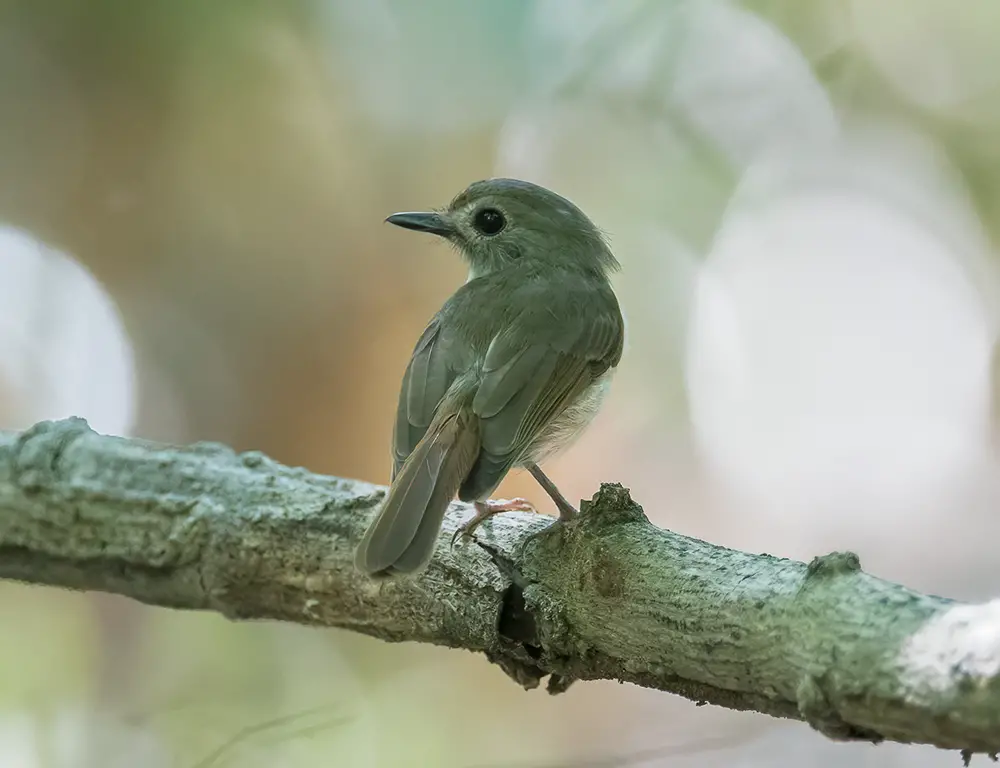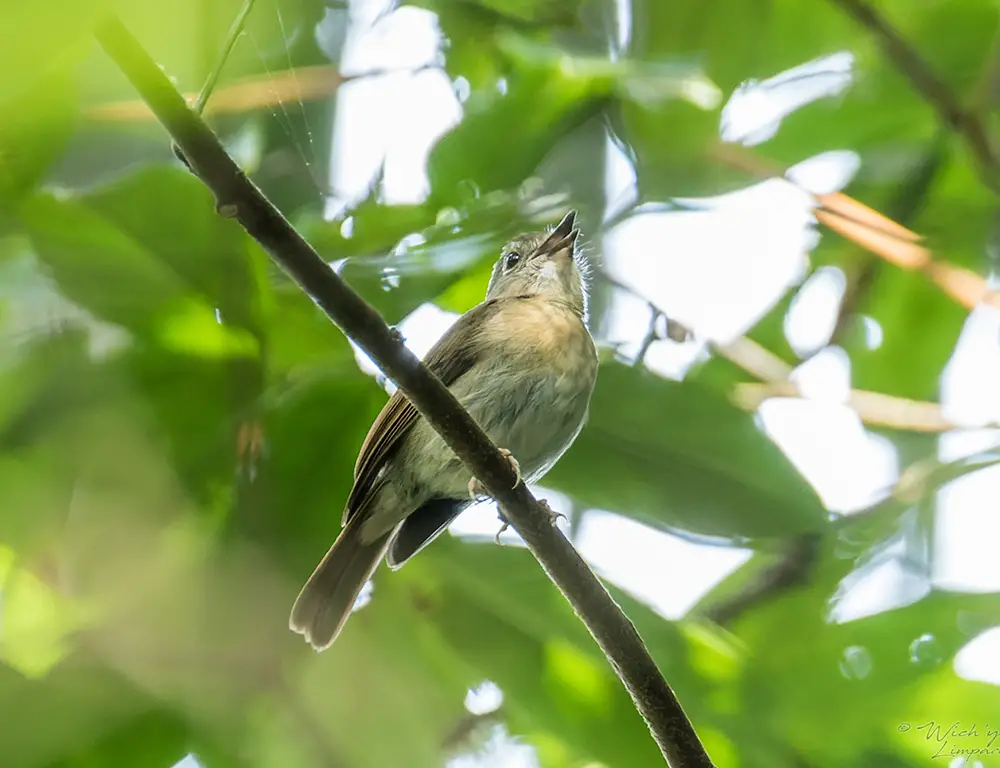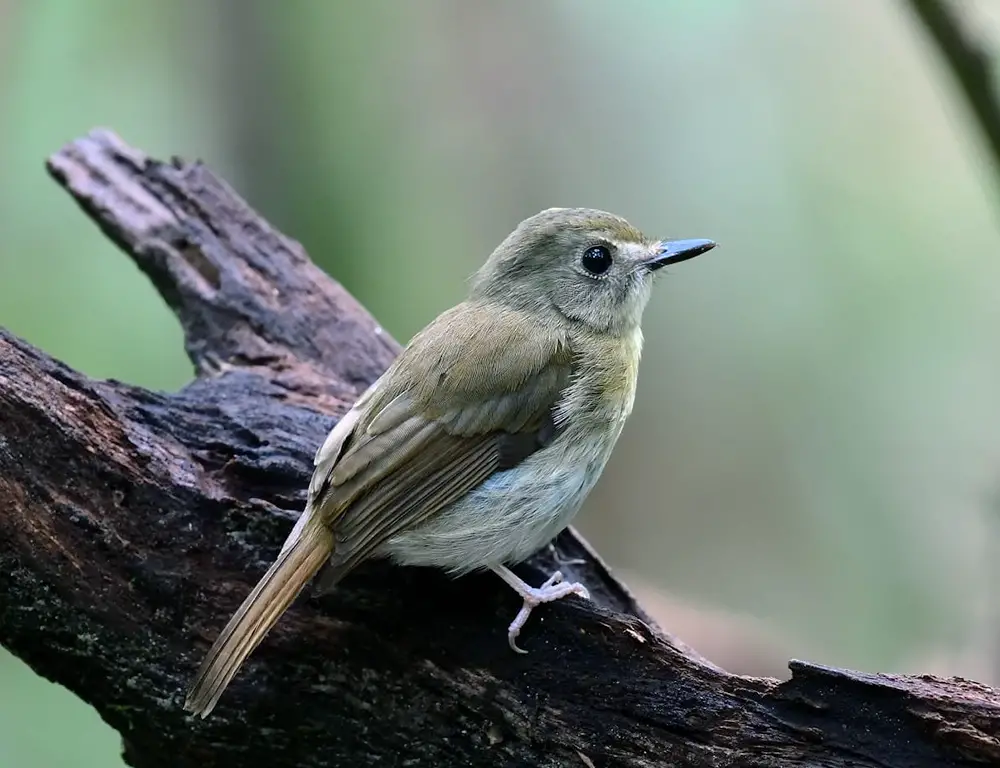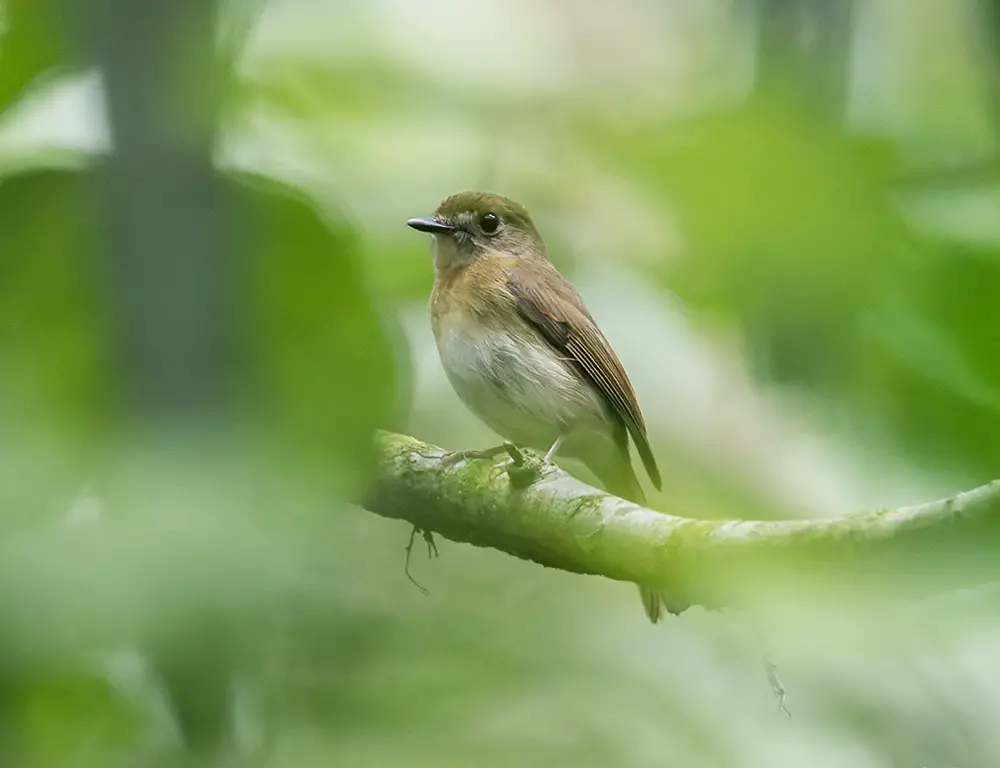In the enchanting birdwatching world, few species possess the captivating charm of the Fulvous-Chested Jungle Flycatcher. Its allure extends beyond the brilliance of its plumage and the melodiousness of its song; it’s a mysterious presence that beckons the observer deeper into its realm.
Originating from the broadleaf forests of Southeast Asia, these flycatchers boast a distinctive appearance, with a fulvous chest and olive-brown back setting them apart from their counterparts.
Despite their elusive nature, seeing these small birds darting through the undergrowth in search of insects is a spectacle worth seeking.
Whether embarking on your first birding expedition or are a seasoned enthusiast, encountering the Fulvous-Chested Jungle Flycatcher promises an unforgettable experience in the rich tapestry of ornithological exploration.

Physical Characteristics of the Fulvous-Chested Jungle Flycatcher
The Fulvous-Chested Jungle Flycatcher (Cyornis olivaceus) possesses a set of physical characteristics that make it both distinctive and well-suited to its environment. Here’s an overview:
Size
Typically, Fulvous-Chested Jungle Flycatchers measure between 15 to 17 centimeters (about 6 to 7 inches) in length. This places them in the category of small birds, allowing them to navigate dense foliage with agility.
Shape
These flycatchers boast a slender and compact physique. Their streamlined bodies enable swift movements, essential for darting through the undergrowth of their forest habitat.
Beak
The beak of the Fulvous-Chested Jungle Flycatcher is short and stout. While it may appear unassuming, it is remarkably efficient for capturing prey. Adapted for an insectivorous diet, this beak allows the bird to seize insects mid-flight quickly.
Coloration
One of the most striking features of the Fulvous-Chested Jungle Flycatcher is its distinctive coloration. As the name suggests, it has a fulvous-colored chest, exhibiting a rich tawny hue.
Its upperparts are characterized by olive-brown plumage, while the underparts are paler. Additionally, the bird sports a striking white eye ring around each eye, adding to its visual appeal.
Variations
While the general coloration pattern described above is typical, individual variations may exist based on age and geographic location. These subtle differences contribute to the species’ overall diversity.
Habitat and Distribution of the Fulvous-Chested Jungle Flycatcher

The Fulvous-Chested Jungle Flycatcher (Cyornis olivaceus) exhibits specific habitat preferences and a distinct distribution pattern that align with its ecological needs.
Here’s an overview of its habitat and distribution:
Habitat
- Tropical and Subtropical Forests: The Fulvous-Chested Jungle Flycatcher thrives in tropical and subtropical forests’ lush, verdant environments. These habitats typically feature dense vegetation, including broadleaf and moist lowland forests.
- Montane Regions: While primarily found in lowland forests, they also inhabit montane regions, albeit less frequently. Their presence in these areas indicates a degree of adaptability to varied altitudes and ecological conditions.
- Forest Edges and Water Bodies: Fulvous-chested jungle Flycatchers often frequent forest edges within their forest habitats, where the transition between forest and open spaces provides a rich foraging ground. Additionally, they are known to maintain territories around water bodies, drawn to areas where insects are abundant and diverse.
Distribution
- Southeast Asia: The Fulvous-Chested Jungle Flycatcher is native to Southeast Asia, with its distribution spanning several countries.
- Primary Range: The species is commonly found in Indonesia and Malaysia, where abundant forest habitats exist. This includes the Malay Peninsula, Sumatra, Borneo, and Java.
- Expansion and Migration: While the primary range encompasses Indonesia and Malaysia, Fulvous-Chested Jungle Flycatchers also occur in neighboring countries such as Thailand.
Additionally, they may exhibit local movements and migrations based on seasonal changes in food availability. However, their distribution remains centered around the forested regions of Southeast Asia.
Behaviors and Diet of the Fulvous-Chested Jungle Flycatcher

The behaviors and diet of the Fulvous-Chested Jungle Flycatcher (Cyornis olivaceus) provide insight into its ecological role and adaptation to its forest habitat.
Here’s an exploration of these aspects:
Feeding Habits
- Insectivorous Diet: The Fulvous-Chested Jungle Flycatcher is primarily insectivorous, relying on a diet of mainly insects. Everyday prey items include ants, beetles, caterpillars, and other small invertebrates in its forest habitat.
- Foraging Strategy: These flycatchers employ a sit-and-wait strategy for hunting. They perch on low branches or foliage, patiently observing their surroundings. When prey is detected, they swiftly launch themselves into action, darting out to capture insects mid-flight with precision.
- Occasional Consumption of Spiders: While insects constitute the bulk of their diet, Fulvous-Chested Jungle Flycatchers may also consume spiders opportunistically, adding variety to their feeding habits.
Breeding Behavior
- Nest Building: During the breeding season, male and female Fulvous-Chested Jungle Flycatchers participate in nest building. The nest is typically a neat cup-shaped structure constructed from various plant materials and nestled among dense foliage, providing protection and concealment for the eggs and chicks.
- Incubation and Parental Care: Once the female lays a clutch of eggs (usually 2-3 per nesting period), both parents share incubation duties. During the day, both sexes take turns incubating the eggs, while the female assumes sole responsibility for nighttime incubation. This collaborative effort ensures the eggs remain protected round-the-clock from potential predators.
- Chick Rearing: Upon hatching, the chicks are cared for by both parents. They receive nourishment and protection until they fledge, typically around two weeks after hatching. This parental care contributes to the survival and development of the offspring, ensuring their successful transition to independence.
Social Behavior
- Territoriality: Fulvous-chested jungle Flycatchers are known to maintain territories within their forest habitats, which they defend against intruders and competitors. These territories provide access to vital resources such as food and nesting sites.
- Vocalizations: Like many bird species, Fulvous-Chested Jungle Flycatchers use vocalizations for communication, including territorial defense and mate attraction. Their calls and songs play a role in establishing and maintaining social bonds within their population.
Conservation Status of the Fulvous-Chested Jungle Flycatcher

The conservation status of the Fulvous-Chested Jungle Flycatcher (Cyornis olivaceus) is of increasing concern due to various threats to its habitat and population.
Here’s an overview of its conservation status and associated challenges:
IUCN Red List Status
The Fulvous-Chested Jungle Flycatcher is categorized as ‘Near Threatened’ on the International Union for Conservation of Nature (IUCN) Red List.
This designation indicates that the species is not currently or critically endangered but is at risk of becoming so shortly if conservation efforts are not implemented effectively.
Habitat Loss and Degradation
One of the primary threats facing the Fulvous-Chested Jungle Flycatcher is habitat loss and degradation. The conversion of forests for agriculture, urbanization, logging, and other human activities has resulted in the fragmentation and loss of its natural habitat.
As a forest-dependent species, the flycatcher’s survival is closely tied to the availability of intact forest ecosystems.
Deforestation
Deforestation, particularly in Southeast Asia, where the species is native, poses a significant threat to the Fulvous-Chested Jungle Flycatcher.
Rapid deforestation driven by logging, clearance for agriculture (such as palm oil plantations), and infrastructure development has led to the loss of critical habitat for the species.
Climate Change
Climate change is another challenge for the Fulvous-Chested Jungle Flycatcher and other forest-dependent species.
Changes in temperature and precipitation patterns can alter the composition and distribution of forests, potentially impacting the availability of suitable habitat and food resources for the flycatcher.
Invasive Species and Pollution
Other threats to the species include the introduction of invasive species, which can disrupt local ecosystems and compete with native species for resources.
Pollution from human activities, including water and air pollution, can also harm the flycatcher’s habitat and health.
Conservation Efforts
Despite these challenges, efforts are underway to conserve the Fulvous-Chested Jungle Flycatcher and its habitat.
Conservation measures include establishing protected areas, such as national parks and wildlife reserves, to safeguard critical habitats for the species.
Additionally, initiatives to promote sustainable land use practices, reduce deforestation, and raise awareness about conserving biodiversity are essential for the flycatchers and other species’ long-term survival.
Let me give you an idea of how serious this is:
| Year | Forest Area (in sq.km) |
|---|---|
| 1990 | 20000 |
| 2000 | 18000 |
| 2010 | 16000 |
| 2020 | 14000 |
Conclusion
The Fulvous-Chested Jungle Flycatcher emerges as a remarkable species, distinguished by its vibrant plumage, fascinating behaviors, and crucial ecological role. Despite facing challenges posed by habitat degradation, conservation efforts remain vital for safeguarding its future.
By preserving their natural habitats and addressing human-wildlife conflicts, we can ensure the continued thriving of these flycatchers and contribute to the broader conservation of biodiversity.
As we continue to study and appreciate this captivating bird, each discovery adds to its allure, underscoring the importance of ongoing research and conservation initiatives.
With dedication and vigilance, we can work towards a future where the Fulvous-Chested Jungle Flycatcher and other species flourish for generations to come.